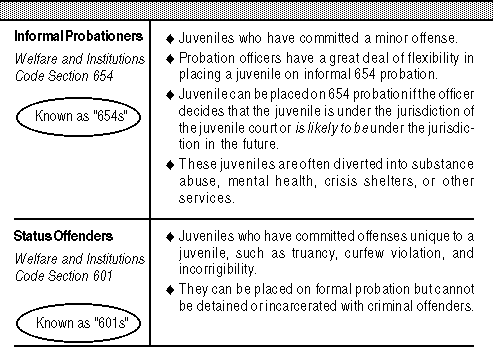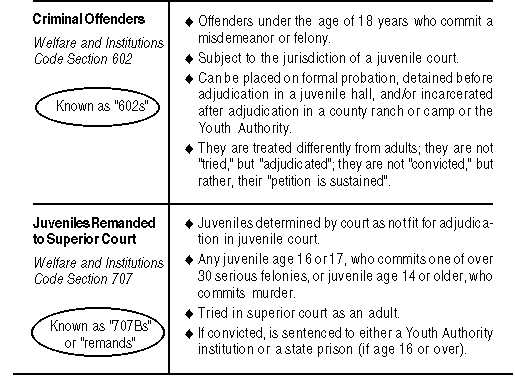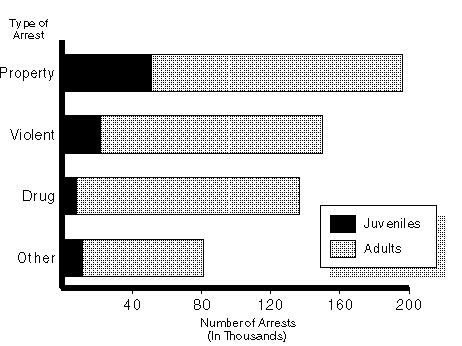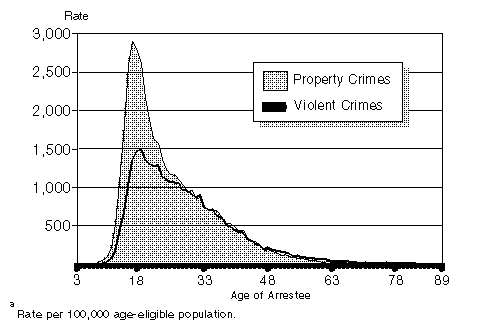What Is Juvenile Crime?
In its simplest definition, "crime" is any specific act prohibited by law for which society has provided a formally sanctioned punishment. This also can include the failure of a person to perform an act specifically required by law.
Types of Offenses. Crimes, whether committed by adults or juveniles, are classified by the seriousness of the offenses as follows:
- A felony is the most serious offense, punishable by a sentence to a state institution (Youth Authority facility or adult prison). Felonies generally include violent crimes, sex offenses, and many types of drug and property violations.
- A misdemeanor is a less serious offense for which the offender may be sentenced to probation, county detention (in a juvenile facility or jail), a fine, or some combination of the three. Misdemeanors generally include crimes such as assault and battery, petty theft, and public drunkenness.
- An infraction is the least serious offense and generally is punishable by a fine. Many motor vehicle violations are considered infractions.
Many types of crimes in California can be charged as either a felony or a misdemeanor (known as a "wobbler"), or as either a misdemeanor or an infraction.
Juveniles, like adults, can be charged with a felony, a misdemeanor, or an infraction. However, as we discuss later, juveniles can also be charged with offenses that are unique to youth.
Categories of Crimes. In general, felonies, misdemeanors, and infractions fall into one of three broad categories: violent, property, and drug-related. Violent crimes refer to events such as homicide, rape, and assault that result in an injury to a person.
Property crimes are offenses with the intent of gaining property through the use or threat of force against a person. Burglary and motor vehicle theft are examples.
Drug-related crimes, such as possession or sale of illegal narcotics, are generally in a separate category altogether. This is because such offenses do not fall under the definition of either violent or property offenses.
The Juvenile Justice System Is Different. The juvenile justice system has evolved over the years based on the premise that juveniles are different from adults and juveniles who commit criminal acts generally should be treated differently from adults. Separate courts, detention facilities, rules, procedures, and laws were created for juveniles with the intent to protect their welfare and rehabilitate them, while protecting public safety.
Under certain circumstances, youthful offenders can be tried either as juveniles or as adults. But even in these situations, their treatment is different from that of adults. For example, a juvenile who is arrested for an "adult" offense can be adjudicated in either juvenile court or adult court; if convicted, he or she can be incarcerated in either a county or state correctional facility or left in the community; and if incarcerated, he or she can be placed with either other juveniles or adults. In contrast, an adult charged with the same offense would be tried in an adult court; if convicted, he or she would be incarcerated by the state and would be housed with adults.
Legal Categories of Juvenile Offenders.Juvenile offenders are generally placed in one of four legal categories depending primarily on the seriousness of the offense committed (see page 6). Two of these categories ("criminal offenders" and "juveniles remanded to superior court") are for juveniles who have committed adult-like crimes. The other categories ("informal probationers" and "status offenders") are for youth who have committed less serious offenses or offenses unique to juveniles, like curfew violations.
Legal Categories of Juvenile Offenders


Who Is Treated As a Juvenile in California?

- Generally, any individual age 18 or older is considered an adult and treated as such in California. Depending on the circumstances, however, someone as young as 14 can be tried in the adult court system and sentenced to the California Department of Corrections (CDC) and housed in the California Youth Authority (CYA); and if 16 years old can be sent to prison. On the other hand, someone as old as 24 can be incarcerated as a juvenile in the CYA.
- There are over 6,000 offenders incarcerated in the CYA who are age 18 or older. The CYA can accept juveniles younger than age 12 after a review by the CYA Director, however, these offenders generally are kept in the community under county probation supervision.
How Much Juvenile Crime Is There in California?
Crime in California, whether committed by an adult or juvenile, is counted in two different ways. One is based on official reports to law enforcement agencies, and is reflected in the national Uniform Crime Reporting (UCR) data and the California Crime Index (CCI) data. Crime is also counted based on surveys of individuals to determine if they have been victims of crime, even though the crime may not have been reported to the police. These data are obtained through national victimization surveys.
Limited Data Available About Juvenile Crime. Many types of data on juvenile crime are not collected or aggregated for the state. For example, we know how many juveniles were arrested for felonies and misdemeanors, but we don t know the disposition of those juvenile arrestees. This is because the state Department of Justice (DOJ) stopped collecting statewide disposition data for juveniles in 1990 for budgetary reasons. As a consequence, we do not know, since 1990, how many juvenile arrestees were adjudicated as juveniles or prosecuted as adults; how many were convicted; how many were placed on probation in the community or incarcerated at the local level. The DOJ reports that it will resume collecting these data in 1995-96.
Consequently, the most currently available data are limited to the number of juvenile arrests, juvenile arrest rates, and the number of juveniles incarcerated at the state level.
Arrest "Rates." Crime data are often presented in terms of "rates." A rate is defined as the number of occurrences of an event within a given population. For example, the overall juvenile arrest rate for California in 1993 was 6,772.8, which means that there were about 6,773 juvenile arrests for every 100,000 youth under the age of 18.
Crime Is Underreported. Crime statistics (for juveniles and adults) from law enforcement agencies don t tell the entire story about the extent of crime for two reasons. First, victimization surveys generally show there is a significant amount of crime committed each year that is not counted in official statistics because it is not reported to law enforcement authorities. According to the U.S. Department of Justice, in 1993 about two-thirds of all crimes went unreported to the police. Specifically, about 50 percent of violent victimizations, almost 60 percent of household crimes, and 70 percent of all personal thefts went unreported.
A second reason crime is underreported is that when several crimes are committed by an offender at the same time, only one (usually the most severe) is counted in the data. For example, if a juvenile offender robbed a store, assaulted a clerk, and killed a customer, only the homicide would be reported.
Juveniles Account for a Significant Number of All Arrests
1993

- In 1993, juveniles accounted for 16 percent of all felony arrests in California.
- Juveniles accounted for 26 percent of all property arrests and 14 percent of violent crime arrests, in 1993.
- In 1988, juveniles accounted for 24 percent of property arrests and 12 percent of violent arrests.
Most Juvenile Felony Arrests Are for Property Crimes
1993

- Juvenile arrests for property crime (burglary, theft, motor vehicle theft, forgery, and arson) accounted for about 57 percent of all juvenile felony arrests in 1993 and arrests for violent crime (homicide, rape, robbery, assault, and kidnapping) accounted for almost 24 percent of all juvenile arrests.
- In contrast, in 1988 property arrests accounted for 61 percent of all juvenile arrests, while violent crime arrests accounted for 17 percent.
- In 1993, there were 2,696 juvenile felony arrests per 100,000 juveniles in California, compared to 2,618 such arrests in 1988.
Total Arrest Rates Higher for Juvenilesa

- Although the arrest rates for juveniles (ages 11 to 17) have consistently been higher than the arrest rates for adults over the past 20 years, they have become much closer in the past five years.
- There is evidence that a major reason that arrest rates for juveniles are higher than for adults is that young men tend to be arrested in large groups on suspicion of committing a crime or at the scene of a crime, although charges may never be filed.
- Juvenile arrest rates peaked in 1974. This was probably due to demographics, that is, the at-risk juvenile population was a larger proportion of the overall state population.
Felony Arrest Rates Highest Among Juvenilesa
1993

- Felony arrest rates for juveniles are consistently higher than those for adults.
- The felony arrest rate peaks at age 16 for property crime and at age 18 for violent crime.
- Although juveniles have a higher arrest rate than adults, juveniles account for a smaller proportion of total arrests than do adults (16 percent versus 84 percent). (Data not shown in figure.)
- While juveniles (11 to 17) accounted for 16 percent of the arrests in California in 1993, they made up only about 9.3 percent of the state's total population.
How Many Juveniles Become Repeat Offenders?
Findings:
Based On:
Details:
Caveats:
Return Juvenile Crime Table of Contents
Return to LAO Home Page